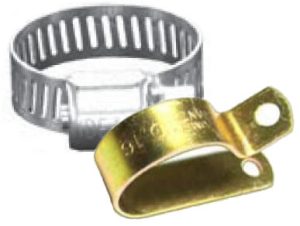
Hos clamps are commonly used in conjunction with fluid- or gas-carrying hoses. They are simple clamping devices that apply pressure to the hose with which they are used. Hoses can leak around fittings. As the fluid or gas inside of a hose heats up, it will become pressurized. The pressurized fluid or gas may then leak out of the hose around fittings. While hose clamps are relatively simple, however, there are several myths you shouldn’t believe.
#1) All Hose Clamps Have a Screw
Some hose clamps do, in fact, have a screw, but others do not. Screw-based hose clamps are known as worm gear clamps. After placing a worm gear clamp around a hose, you can turn the screw. Turning the screw clockwise to tighten the worm gear clam. Worm gear is just one of several types of hose clamps. Others include ear clamps, wire clamps and spring clamps.
#2) No Standards Available
Another common myth is that there are no standards available for hose clamps. There are actually several hose clamp standards. The Aerospace Industries Association, for instance, offers the NAS1922 and NAS1924 standards, whereas the Society of Automatic Engineers (SEA) offers the J1508 standard. These standards govern the design and specification of hose clamps.
#3) Made Exclusively of Metal
You can find hose clamps in different materials. While most of them are made of metal, such as stainless steel, others are made of synthetic materials. Spring clamps are often made of a semielastic plastic. They are known as “spring clamps” because they work like a spring. You can pull a spring clamp open, after which you can place it over a hose. Upon releasing it, the spring clamp will apply pressure to the hose like a typical spring.
#4) Only Used in Automobiles
When most people think of hose clamps, they envision the clamps used in coolant hoses for cars and trucks. But hose clamps aren’t used exclusively in automobiles. They are used in airplanes and other types of aircraft as well. Airplanes feature fluid- or gas-carrying hoses — just like automobiles. To prevent these hoses from leaking when pressurized, they require hose clamps.
#5) Last Forever
Unfortunately, hose clamps don’t last forever. Over time, they may lose their ability to apply strong, consistent pressure to the hose with which they are used. This can result in leaks, allowing fluid or gas to escape the hose. You can prevent this from happening by regularly tightening or replacing hose clamps.



